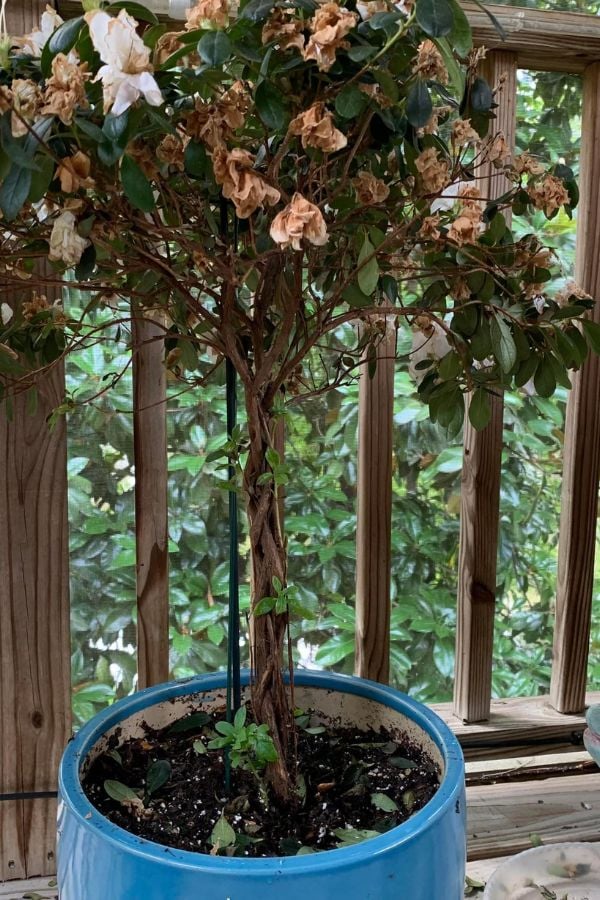I’ve recently delved into the best practices for watering Azaleas and wanted to share some insights that could help you with your Azalea care as well. Due to my work schedule, I can only water my Azaleas either between 9:30 AM or 2:30 PM (14:30). Which of these times would be better for the plants?
In the morning, the sun shines directly on the Azaleas from their roots to the top. However, by 2:30 PM, the base is shaded by a fence. Last year, I was quite upset because I lost one of my Azaleas, likely due to improper watering. I’m eager to get it right this year.
From what I’ve learned, Azaleas and similar plants have shallow, spreading roots. They can quickly develop growth problems or die if their base is exposed to excessive direct sunlight. This might have been the issue with my plant.
Therefore, it’s recommended to water them when it’s not too hot. Additionally, to boost moisture retention and shield them from direct sunlight, covering the soil surface with straw, leaf mold, or bark chips can be beneficial.
But it’s important to note that leaf mold might attract some insects. This method of covering the soil helps keep it cooler and preserves moisture for a longer duration.
Contents
Here is How To Water An Azalea Correctly?
Before getting into the specifics of watering Azaleas during their blooming period, it’s important to figure out when to water in general. Gardeners advise paying attention to the soil’s moisture.
Typically, if the soil feels dry, it’s time to water the plant. But sometimes, it’s hard to tell if watering is needed. In such cases, I recommend lifting the pot. If it feels heavy, you can wait a bit longer before watering.
Watering Options During Blooming
- Submersion Method: Place the Azalea pots in a large container of water for 3 hours. This is ideal for those with many plants, as the soil absorbs the water independently. After this, you can skip watering for 2-3 days.
- Drip Method: Use a watering can or a sprayer to mist the leaves and other parts of the plant. It’s best to do this in the morning, evening, or on cloudy days to prevent leaf burn from the sun.
Main Recommendations for Effective Watering
- Before Blooming (March to October): Reduce watering. Increase the amount of water in November and during the summer if the air is too dry for the plant.
- To Increase Bud Size: Limit watering in the winter and move indoor plants to a cooler place, like a glazed balcony or porch.
- After Buds or Flowers Appear: Move the Azalea to a warmer spot, around 60-64 degrees Fahrenheit (16-18 degrees Celsius), and increase watering.
It’s crucial to note that Azaleas can bloom for up to 2 months, but this is only achievable with proper watering and maintaining the right level of humidity. Otherwise, the blooming period might be reduced to just 2 weeks.
Watering Indoor and Outdoor Azaleas
For indoor Azaleas you need to adjust the watering based on the room temperature. Decrease watering as the temperature drops, and increase it when it gets warmer.
When it comes to Azaleas planted in the garden or on a plot, the frequency and intensity of watering depend on the weather and the planting location.
For instance, if the plant is in an area with a high groundwater level, it’s better not to water it too frequently.
However, those planted in higher, sandy areas need more frequent and thorough watering. In these cases, watering with one to two buckets (approximately 2 to 4 gallons [7.5 to 15 liters]) every other day is ideal.
For young, newly planted seedlings, half a bucket (about 1 gallon [3.8 liters]) 2-3 times a week should suffice.
What Kind of Water to Use for Watering?
Azaleas are a bit demanding when it comes to care. For watering these plants, it’s not a good idea to use hard or chlorinated water. Both can harm the plant and hinder its growth and development.
I’ve found that it’s better to use soft water that has been allowed to sit for 2-3 days. You can also use boiled water, softened with a bit of oxalic acid or lemon juice.
When growing Azaleas in a garden or park, you can use rainwater for watering. However, experienced gardeners advise filtering the water with household filters or letting it settle for about 4 days (96 hours) to remove any impurities.
What To Consider When Watering Azaleas?
Watering Azaleas requires a careful approach. It’s crucial to consider not just the growth stages of the plant, but also various other factors.
Let’s dive into how to water Azaleas depending on the time of year and growing conditions.
Seasonal Watering
The time of year is a significant factor in determining how much water to add to the soil. Here’s a seasonal guide I’ve found useful:
- March to September: During these months, it’s recommended to water the Azalea once every two days. In the summer, especially if it’s hot and dry indoors, increase the amount of water and mist the plant periodically.
- October to November: This is the bud-forming period for Azaleas, which doesn’t require frequent watering. Moistening the soil about once every 3-4 days is sufficient.
- December to February: Gardeners advise inducing a dormancy period by reducing watering to once or twice a week and moving the pots to a cooler location. If the indoor air is dry, you might need to water more often, but morning misting of the leaves is preferable.
It’s important not to overdo watering in any season, but also remember that the plant needs moisture. Regularly check the soil’s condition and visually assess the plant’s health.
Common Mistakes in Watering Azaleas
Beginner flower growers should familiarize themselves with the watering nuances of Azaleas, both indoors and outdoors. Azaleas enjoy moisture, so it’s crucial to prevent the soil from drying out.
- Overwatered Soil: This leads to oxygen deprivation and root rot. If uncorrected, the plant’s leaves, flowers, stems, and roots will start dying.
- Dry Soil: This can cause the plant to wilt gradually. However, you can revive an Azalea with dry soil by placing it in a container with warm, settled water for 4 hours. Afterward, ensure regular watering every 2-3 days.
Timely watering and proper care will extend the blooming period and improve the plant’s overall health.







